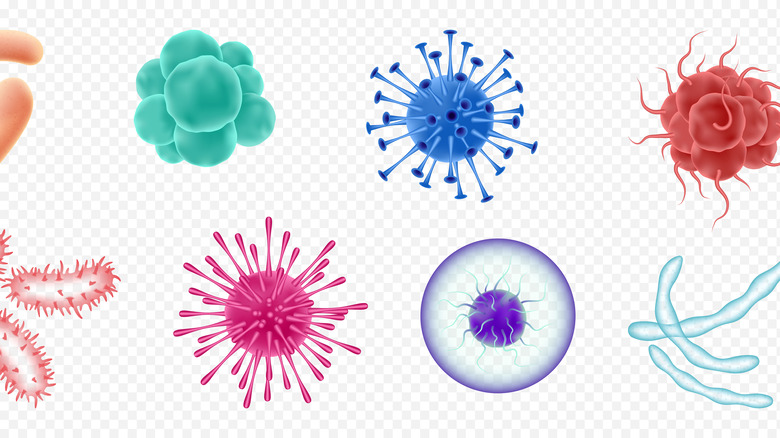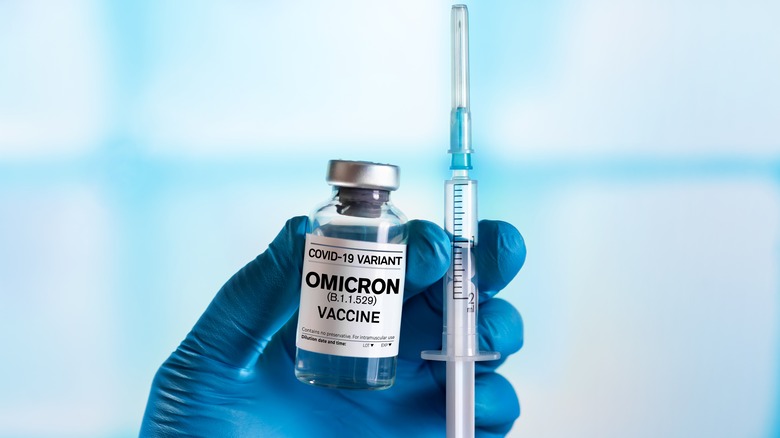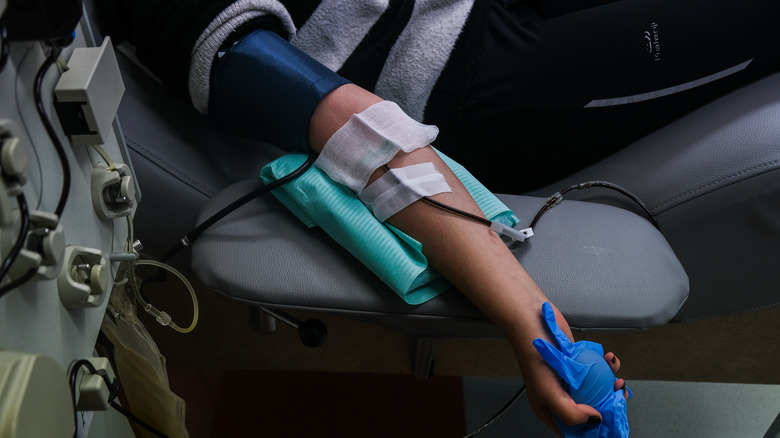Guillain-Barré Syndrome Explained: Causes, Symptoms, And Treatments
If you've never heard of Guillain-Barré syndrome, we won't blame you. Also known as acute inflammatory demyelinating polyradiculoneuropathy (AIDP), this rare disorder only affects around 3,000 people in the United States, according to Johns Hopkins Medicine. It is classified as a "neurological disorder" and has an adverse effect on the body's peripheral nervous system (this means it does not affect the spinal cord and brain, thankfully).
Guillain-Barré syndrome can develop suddenly and without warning — some people develop symptoms over the course of a few weeks while others experience symptoms in a matter of days. Initially, these include tingling and muscle weakness in the upper body and arms (via the Centers for Disease Control and Prevention). Patients with this syndrome need immediate medical care and hospitalization to prevent symptoms from worsening and causing paralysis.
According to the Mayo Clinic, there is no cure for Guillain-Barré syndrome, but there are existing treatments that can help manage the condition. Doctors are also still scratching their heads when it comes to figuring out what exactly triggers the syndrome. While rare, this condition must be taken seriously. Read on for everything you need to know about Guillain-Barré syndrome, including its various causes, symptoms, and existing treatments.
There are different forms of Guillain-Barré syndrome
Guillain-Barré syndrome can manifest in three different forms, and each has its own set of symptoms. Some forms of Guillain-Barré are more prominent in certain parts of the world than others (via the Mayo Clinic).
The most common form of Guillain-Barré syndrome in the United States is acute inflammatory demyelinating polyradiculoneuropathy (AIDP). This form of the syndrome is also commonly seen in North America and European regions. Telltale signs to look out for include muscle weakness concentrated in the lower body that eventually starts to affect the upper body.
Another form of the syndrome known as acute motor axonal neuropathy (AMAN) and acute motor-sensory axonal neuropathy (AMSAN) is commonly seen in countries like Mexico, China, and Japan. It does occur in the U.S., but it's less common than AIDP. AMAN is known for bringing about sudden weakness in patients and can be so severe that they experience respiratory issues. AMSAN, on the other hand, causes feelings of numbness and tingling in the body, according to Medical News Today.
Miller Fisher syndrome (MFS) is another form of Guillain-Barré syndrome that's more common in Asia than in the U.S. This form of the syndrome paralyzes the eyes first and can affect a person's gait, causing issues with walking and overall balance. Only 5-10% of U.S. citizens with Guillain-Barré experience this form of the syndrome, according to a 2014 study published in Neurologic Clinics.
Various things can cause Guillain-Barré syndrome
As previously mentioned, the exact cause of Guillain-Barré syndrome is still a mystery to medical professionals, but there are some things doctors suspect can trigger the condition
Guillain-Barré syndrome can affect anyone, but it's typically seen more often in patients who are in their 50s and above, according to WebMD. At its core, the syndrome's symptoms are a result of a glitch in the body's immune system, and doctors are still theorizing whether some germs or viruses are responsible. One theory is that some viruses and bacteria can cause the immune system to be reprogrammed to attack the wrong cells. Another theory is that they work to change the makeup of nerve cells which then triggers the immune system to launch an attack.
Doctors have noticed that many patients with Guillain-Barré syndrome dealt with other conditions prior to contracting the syndrome. Diarrhea caused by the Campylobacter jejuni bacteria appears to be one of the "most common causes of GBS," according to the Centers for Disease Control and Prevention (CDC). In the United States alone, one in every 1,000 people who get infected with Campylobacter jejuni goes on to develop Guillain-Barré syndrome. Doctors have also found that around eight in every 20 people who get treated for the syndrome in the United States report having dealt with a recent Campylobacter infection. Respiratory illnesses also seem to be a trigger for some people as well as viral infections like the flu, the Zika virus, the Epstein Barr virus, and the cytomegalovirus.
Can a vaccine cause Guillain-Barré syndrome?
According to Healthline, developing Guillain-Barré syndrome after receiving a flu vaccine is incredibly rare, but it does happen. To put it into perspective, the Centers for Disease Control and Prevention (CDC) reports that one to two people out of 1 million go on to develop Guillain-Barré syndrome after receiving a flu shot. The CDC also reports that studies have shown people are way more susceptible to the syndrome after getting ill with the flu than when they receive the vaccine.
When COVID-19 brought the world to a standstill, various vaccines were formulated to help combat the virus. The Johnson & Johnson vaccine in particular was shown to possibly make people more likely to develop Guillain-Barré syndrome. The FDA released a statement on July 13, 2021, informing the public of this possible side effect but also making it clear that studies have not found a causal relationship between the Janssen (Johnson & Johnson) vaccine and Guillain-Barré syndrome. Cases of people developing the syndrome after receiving the vaccine were rare — out of the 12.5 million doses that had already been administered at the time, 100 cases of Guillain-Barré syndrome were reported.
The FDA reported that people's risk of developing the syndrome was highest in the first 42 days after receiving the vaccine. Cases were still so few, however, that this syndrome remains a rare occurrence despite millions receiving the Johnson & Johnson vaccine. According to Healthline, people should keep in mind that both the CDC and FDA continually monitor the safety and side effects of vaccines.
The following symptoms indicate Guillain-Barré syndrome
While Guillain-Barré syndrome is rare, it's good to know what symptoms to look out for. According to the World Health Organization (WHO), symptoms of the syndrome can continue for a couple of weeks, but most people manage to beat the disease without having to deal with lingering neurological issues if they receive treatment in time.
One of the symptoms of Guillain-Barré syndrome is a feeling of weakness or tingling that typically starts in the legs. Eventually, these sensations spread to other parts of the body like the arms and even the face. According to the Cleveland Clinic, you might also experience back pain accompanied by muscle weakness. Some people start to notice issues with their blood pressure and heart rate. The WHO warns that some of the symptoms associated with the syndrome can lead to other, more severe symptoms and complications, like paralysis. The syndrome can affect a patient's chest muscles — this occurs in around 20-30% of people — which can cause respiratory problems. For some, symptoms can become severe, and issues with swallowing and speaking could start to pop up. These symptoms should be taken seriously and the patient should receive medical care ASAP.
Guillain-Barré syndrome can cause some life-threatening complications, like cardiac arrest, respiratory failure, lung clots, and even blood infection. Around 3-5% of patients with the syndrome die from these complications. The good news is that far more people make a full recovery despite experiencing severe symptoms.
Various tests are used to diagnose Guillain-Barré syndrome
According to Johns Hopkins Medicine, it can be challenging to diagnose Guillain-Barré syndrome when it's still in its early stages of development. To ensure doctors diagnose you correctly, they might suggest you undergo two tests: a spinal tap and electromyography. While these tests won't always provide black-and-white answers as to whether or not you have the syndrome, they can help doctors rule out any other causes of your symptoms.
A spinal tap, which is also referred to as a lumbar puncture, can help doctors figure out whether you suffer from any other infections that possibly mimic the symptoms of Guillain-Barré syndrome. During the spinal tap, your doctor will insert a small needle into your back to extract cerebrospinal fluid (this fluid surrounds your brain and spinal cord). They will then send it for analysis, which will reveal whether you have any other infections or illnesses. If you do have Guillain-Barré syndrome, the analysis might pick up some things that are indicative of the disease, which can help your doctor make a final diagnosis (via the Cleveland Clinic).
Electromyography (EMG) and nerve conduction velocity (NCV) are other tests your doctor might order to help them make an accurate diagnosis. The procedure consists of injecting electrodes into muscles or placing them over the skin covering muscle groups. Then, your doctor will observe how your motor neurons and muscles operate by looking at the muscle responses and electrical activity. Any sign of nerve damage can be indicative of the syndrome.
There are ways to treat Guillain-Barré syndrome
While no cure exists for Guillain-Barré syndrome (yet), there are ways to successfully treat the condition. According to the World Health Organization (WHO), immunotherapy is usually the first course of action when the syndrome is in its acute phase. Two of the most popular treatments are immunoglobulin and plasmapheresis, according to Johns Hopkins Medicine.
Immunoglobulin is a treatment used to help stop the immune system's erratic response to the nervous system and hence prevent the progression of the disease. According to WebMD, this procedure consists of administering healthy cells to the body via an IV. Plasmapheresis does the same thing, in a sense. Its main focus is to reduce or entirely remove the antibodies present in your blood to help curb the syndrome's symptoms. This is done by using other fluids to replace the liquid part (plasma) of your blood. According to Healthline, you'll get hooked up to a machine that will remove your blood, "clean" it, and then transfuse the blood back into your body.
While you're in the hospital, your doctor might administer other treatments to help relieve symptoms, like pain medication. The aforementioned treatments will focus on the root cause, reducing inflammation while also suppressing the immune system so it stops attacking healthy cells. In some cases, patients need additional treatment like physical and hormonal therapy to help them regain their strength and flexibility after suffering from the syndrome.
You can recover from Guillain-Barré syndrome
According to the Cleveland Clinic, Guillain-Barré syndrome clears up within weeks for some, while others can take years to recover. However, the latter is less common, and patients typically see an improvement in symptoms within a few months of receiving treatment. Healthline explains that people can expect their symptoms to be the most intense for two to four weeks. After this, you'll typically start to notice improvements.
In an article Dr. Suchita Shah wrote for Patient, she explains that most people who suffer from the syndrome make a full recovery within a six to 12-month period. However, for some patients, the recovery period can last as long as two years, according to the National Institute of Neurological Disorders and Stroke. Only 30% of people still struggle with weakness three years after contracting the syndrome while 15% never fully regain their former strength and might need a wheelchair or walker to get around. Only 3% of patients tend to experience a recurrence of muscle weakness and tingling sensations a few years after they first contracted the syndrome. The good news is that 70% of people usually recover fully, while only 5% of cases tend to be fatal.
According to Medical News Today, making an appointment with your doctor immediately after you start to experience symptoms of Guillain Barré syndrome can be what makes the difference between a full recovery and dealing with life-threatening complications later on.
You might need help to cope with the syndrome
What makes Guillain-Barré syndrome such a debilitating disease is the fact that it can cause some people to need extra help to do basic, everyday tasks for a while.
According to the Cleveland Clinic, there are patients who need help to function normally from day to day while dealing with symptoms or lingering complications. They might need someone to help them eat, bathe, and dress. Experiencing ongoing fatigue can also wreak havoc on people's lives. According to the National Institute of Neurological Disorders and Stroke, rest is the best remedy when struggling with this symptom — make sure you don't have too much on your plate at any given time. According to WebMD, it is sometimes necessary to have full-time support from a friend, family member, or a nurse if you suffer from Guillain-Barré syndrome, especially if performing everyday tasks proves challenging.
While the physical limitations can be incredibly frustrating, Guillain Barré syndrome can also have an adverse impact on a patient's mental health. Adapting to being paralyzed or weakened and needing someone else to do everything for you can be mentally taxing. It is recommended that patients with severe ongoing symptoms speak to a psychologist or therapist that can help them navigate the changes they're experiencing. There are also some support groups patients can join, which can help them realize that they are not alone and even provide tips on how to best navigate the disease.
You might deal with some complications
One in five people affected by Guillain-Barré syndrome ends up dealing with long-term complications, according to the NHS. These complications include having issues with your balance and coordination, lingering tingling or burning sensations, pain, and numbness. Some people also experience continued weakness in certain areas of their body, like their face, arms, and legs. Some have difficulty walking on their own as well. Others deal with more serious complications, like having difficulty breathing once the syndrome spreads to respiratory muscles (via Healthline). In some cases, people need a respirator to breathe normally once this happens.
And because paralysis can occur, patients can struggle with bedsores and blood clots due to a lack of movement. Problems with blood pressure and the heart, as well as slower bladder and bowel function, can also materialize.
There are, however, things that can be done to minimize the impact some of these complications have. For example, using compression stockings or blood thinners can help you prevent or at least manage clotting, while ensuring that you don't lie or sit in one position for prolonged periods of time can help prevent and relieve bedsores. Patients can also opt for additional treatment like occupational therapy, speech, and language therapy, and physiotherapy to help them deal with complications like swallowing, having difficulty speaking, and other physical challenges.
When to see a doctor
It's imperative that Guillain Barré syndrome be diagnosed as early as possible to prevent life-threatening and lasting complications. The Mayo Clinic recommends you contact your doctor immediately if you experience any kind of tingling sensation in your fingers or toes that stick around but also doesn't seem to increase in intensity. This could be a sign that you're in the early stages of the syndrome and getting treated as soon as possible is crucial to prevent symptoms from worsening.
Some symptoms of the syndrome require immediate medical attention. This includes choking on saliva, experiencing shortness of breath when you're lying down, or noticing that you constantly feel out of breath without doing physically exerting activities. If the tingling you experienced in your toes or feet starts to spread to the rest of your body, it's another sign that you're in need of urgent medical care, especially if it spreads at an alarming pace. The NHS warns that being unable to speak properly and experiencing paralysis in your face and other limbs are other telltale signs that emergency medical care is required.
When symptoms are severe, hospitalization needs to be instant — the above-mentioned symptoms can intensify at an alarming pace, and if you receive speedy treatment, you'll have a better chance at a full recovery.











